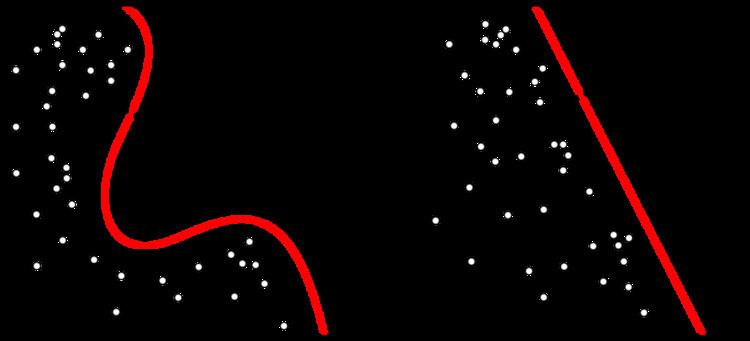 | ||
Ordering points to identify the clustering structure (OPTICS) is an algorithm for finding density-based clusters in spatial data. It was presented by Mihael Ankerst, Markus M. Breunig, Hans-Peter Kriegel and Jörg Sander. Its basic idea is similar to DBSCAN, but it addresses one of DBSCAN's major weaknesses: the problem of detecting meaningful clusters in data of varying density. In order to do so, the points of the database are (linearly) ordered such that points which are spatially closest become neighbors in the ordering. Additionally, a special distance is stored for each point that represents the density that needs to be accepted for a cluster in order to have both points belong to the same cluster. This is represented as a dendrogram.
Contents
Basic idea
Like DBSCAN, OPTICS requires two parameters:
The reachability-distance of another point
If
Both the core-distance and the reachability-distance are undefined if no sufficiently dense cluster (w.r.t.
The parameter
Pseudocode
The basic approach of OPTICS is similar to DBSCAN, but instead of maintaining a set of known, but so far unprocessed cluster members, a priority queue (e.g. using an indexed heap) is used.
OPTICS(DB, eps, MinPts) for each point p of DB p.reachability-distance = UNDEFINED for each unprocessed point p of DB N = getNeighbors(p, eps) mark p as processed output p to the ordered list if (core-distance(p, eps, Minpts) != UNDEFINED) Seeds = empty priority queue update(N, p, Seeds, eps, Minpts) for each next q in Seeds N' = getNeighbors(q, eps) mark q as processed output q to the ordered list if (core-distance(q, eps, Minpts) != UNDEFINED) update(N', q, Seeds, eps, Minpts)In update(), the priority queue Seeds is updated with the
OPTICS hence outputs the points in a particular ordering, annotated with their smallest reachability distance (in the original algorithm, the core distance is also exported, but this is not required for further processing).
Using a reachability-plot (a special kind of dendrogram), the hierarchical structure of the clusters can be obtained easily. It is a 2D plot, with the ordering of the points as processed by OPTICS on the x-axis and the reachability distance on the y-axis. Since points belonging to a cluster have a low reachability distance to their nearest neighbor, the clusters show up as valleys in the reachability plot. The deeper the valley, the denser the cluster.
The image above illustrates this concept. In its upper left area, a synthetic example data set is shown. The upper right part visualizes the spanning tree produced by OPTICS, and the lower part shows the reachability plot as computed by OPTICS. Colors in this plot are labels, and not computed by the algorithm; but it is well visible how the valleys in the plot correspond to the clusters in above data set. The yellow points in this image are considered noise, and no valley is found in their reachability plot. They will usually not be assigned to clusters except the omnipresent "all data" cluster in a hierarchical result.
Extracting clusters from this plot can be done manually by selecting a range on the x-axis after visual inspection, by selecting a threshold on the y-axis (the result will then be similar to a DBSCAN clustering result with the same
Complexity
Like DBSCAN, OPTICS processes each point once, and performs one
In particular, choosing
Extensions
OPTICS-OF is an outlier detection algorithm based on OPTICS. The main use is the extraction of outliers from an existing run of OPTICS at low cost compared to using a different outlier detection method. The better known version LOF is based on the same concepts.
DeLi-Clu, Density-Link-Clustering combines ideas from single-linkage clustering and OPTICS, eliminating the
HiSC is a hierarchical subspace clustering (axis-parallel) method based on OPTICS.
HiCO is a hierarchical correlation clustering algorithm based on OPTICS.
DiSH is an improvement over HiSC that can find more complex hierarchies.
FOPTICS is a faster implementation using random projections.
HDBSCAN* is based on a refinement of DBSCAN, excluding border-points from the clusters and thus following more strictly the basic definition of density-levels by Hartigan.
Availability
Java implementations of OPTICS, OPTICS-OF, DeLi-Clu, HiSC, HiCO and DiSH are available in the ELKI data mining framework (with index acceleration for several distance functions, and with automatic cluster extraction using the ξ extraction method). Other Java implementations include SPMF and in the Weka extensions (no support for ξ cluster extraction). The R package dbscan includes a C++ implementation of OPTICS (with both traditional dbscan-like and ξ cluster extraction) using a k-d tree for index acceleration for Euclidean distance only.
